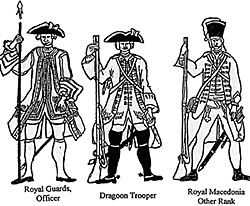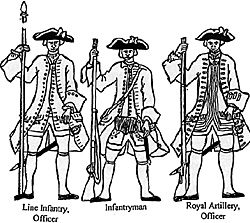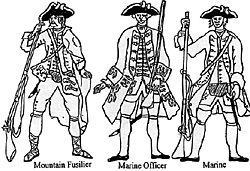Don Carlos, son of Spain's Philip V, was namd King of Naples and Sicily as Charles VII in 1734. He was recognized in this title by all of the belligerents by 1738.
[1]
In order to establish a proper army he was given several Spanish, Walloon and Irish units by his father, and had native Italian unuts raised during the recent war. Swiss troops were hired and, eventually, more Italian units were raised. Therefore, it was an army that was heavily influenced by Spanish uniform styles.
An important source for their uniforms is Divisas y Antiguedades de sodas las Tropas que estan al glorioso servizio de S.M.S...in 1755. (i.e. Uniforms and Procedures of all of the
troops in the glorious service of His Serene Highness...in 1755) - a sort of Neapolitan "Clothing Book").
It shows naive-style water colour plates of an officer and an other rank for units raised by 1755. (as can be seen by my naive tracings of the drawings, which accompany this article). Unfortunately, over the course of time, the colours of the original plates had changed. For example, blue had turned into green or violet, in other plates was unchanged, and in some had turned brown! (causing some erroneous reports on uniform colours). Fortunately, there are written records which allowed the facing of the proper colours through descriptions on government-issued receipts for the uniforms delivered by contractors. [2]
The term facings in the uniform tables refers to the collar, cuffs and lining/turnbacks; exceptions or special items of dress, such as lapels, are noted elsewhere in this article.
Veteran regiments were of two battalions, each of 13 companies of 50 men, one of which was a grenadier company (except where noted differently). Note that the "Veteran" title is more the equivalent of "established" or "line" regiments rather than a commentary on the quality of the troops. Provincial regiments were composed of single battalions of seven 57-man companies for a total of 399 men, including one company of grenadiers. [3]
All fusilier ranks wore a black felt tricorne trimmed in white or yellow matching the metal of the buttons on the coat (cloth for other ranks, silk for NCO's and gold or silver lace for officers). For most units, the left wing of the hat bore a red cockade held in place by a central strip of white or yellow lace.
Grenadiers wore a Spanish-style fur cap with a bag. The bag matched the facing color and was trimmed and tasselled to match the button color. Also in common with Spanish grenadiers, curved
swords were worn.
A knee-length coat called a giamberga, was worn. It had ample cuffs, and a lining of Lhe distinguishing color which was worn turnbacked by the men. Although the post-war uniforms of Divisas show collars worn by other ranks, so far none of the clothing contracts found for the WAS period mention them. A self-colored shoulder strap on the left shoulder served to hold a crossbelt in place. Evenly spaced buttons, generally a row of nine, ran down the right side of the coat. Coats had three-pointed pocket flaps with 3 buttons (although some offlcers are shown with more). Officers' coats were of better quality cloth, without collars and were worn loose, not turnbacked. Most of the officers are also shown with 3 buttons on their cuffs.
A long-sleeved waistcoat called a giamberghino, which reached to mid-thigh, was worn. It was usually in the same color as the facings. It also had three-pointed pockets with buttons as on the coat. I will refer to it as a vest for the rest of this article.
Tight, knee-length breeches were worn, almost always in the color of the coat. However, some officers and cadets wore breeches matching the facing colors. It was not a distinguishing feature between regiments. All ranks wore white gaiters and white linen shirts and neck stocks.
Officers wore a gorges in the opposite metal to their buttons, decorated with a fleur-de-lys surrounded by leaves in the button metal color. They were armed with a straight sword and a spontoon, as ordered in the Spanish Ordinance of 1728 that also governed the Neapolitan army. The sword belt was not visible, being worn beneath the vest. Sergeants were armed with a halberd and sword under the same ordinance.
Drummers and musicians of the Guards and some of the regiments bearing Royal Family titles wore coats and breeches in blue, with red vests and facings trimmed in the Boubon livery (Red
tape with a white chain pattern, running along the coat seams and the edges of the pockets, cuffs, collar and vest). The drummers of the majority of the other regiments wore reversed colors. Drums were generally painted in the facing color with the royal, or regimental, arms painted on them.
The flags followed the Spanish model, but with Neapolitan arms and military orders replacing the Spanish ones. Thus the infantry regiments would have had a white colonel's color charged with the royal arms, and two white Ordinance flags characterized by the red cross of Burgandy. The cavalry would have had similar flags, but of reduced size and with a crimson red background. It is likely that the Spanish units would have initially retained their original flags, such as the Irish green flag charged with a golden harp. The Swiss carried their traditional flags with a large white cross and multi-colored flames in each of the cantons.
Guardie de Corpo/Gards du Corps: had one 180-man company. This company was comprised exclusively of nobles, from officers to the lowest ranker and all ranked as officers in the
regular army. Thus all ranks were clean shaven, wore their coat skins loose instead of turnbacked, and had no collars. Lace for all ranks was silver in the same positions as illustrated for the Guard infantry. Red stockings and black shoes were worn when on foot, and cavalry jackboots when mounted. The troopers' carbine belts were medium green edged in silver lace. They were divided into squares by strips of silver lace as in the French and Spanish Garde du Corps regiments.
Reali Guardie Italianen Italian Royal Guards: even though lace and loops were white, all buttons were brass. A round gilt plate with the fleur-de-lys decorated the cartridge box.
Reali Guardie Svizzere Swiss Royal Guards: had two battalions, each of four 175-man companies for a regimental total of 1,400 men. All ranks wore blue breeches. Cartridge boxes for all the Swiss units were slung from a shoulder belt instead of on the waistbelt.
del Re/King's Regiment: originally the Spanish-Irish Limerick regiment. Continuing a tradition from their Spanish service, they wore a black cockade.
della Regina/Queen's Regiment: originally the Spanish-Italian Sicilia Regiment.
Reale Macedonia/Royal Macedonia: had only one Battalion [4] . Raised in 1739 from Albanians. During the siege of Velletri they captured 400 prisoners during the storming of Mount Artemisio, and later managed to persuade some 600 Austrian grenzers on outpost duty, to desert. Present at the sieges of Tortona and Piacenza. Besieged in Guastella for two months in 1745, they surrendered but were quickly exchanged for the Austrian Sprecher Regiment. All ranks wore a grenzer-style uniform. This included a black busby with a short red bag, piped and tasselled in white. The mens' busbies were trimmed in white on the top. All ranks wore tight, red Hungarian-style breeches with white lace knots, a red sash, and a blue pointed vest and pointed blue cuffs trimmed with narrow white lace. All ranks were armed with a Balkan-style musket and brass hilted sword (the men had bayonet too) and are shown wearing mustaches. Short black boots were worn. The cartridge box was worn slung from a shoulder belt.
Reale Artiglieria/Royal Artillery: one 880-man battalion. The men wore standard infantry dress, but with three horizontal loops on their cuffs and they had a gilt "RA" on their
cartidge boxes. The officers' coats had standard pockets, but the buttonholes on its flaps and the buttons on the coat were laced. The vest was edged with two fairly wide strips of gold lace; and pockets were also laced. (see illustrations).
Walloons: were originally Spanish units; all continued to wear the black cockades that they had worn in Spanish service. They were organized in the same manner as veteran units
and they wore standard uniforms.
Swiss: had two battalions, each of four 175-man companies for a regimental total of 1,400 men. All ranks wore blue breeches. They did not wear the cartidge box on the waistbelt, but wore it suspended from a shoulder belt. They are also shown as having coats and vests with buttons on both sides. The officers are all shown with various amounts of silver lace - as false buttonholes and on vest pockets, for example, but none of these seem to be standardized and so I believe that these represent personal preferences by the owner.
Wirtz: officers and men had blue, rounded lapels that reached to about a third of the way down the coat [5] . The officer is shown with false buttonhole lace on his lapels and vest.
Provincial or National (militia) Units: unlike the veteran units, provincial officers had collars on their coats, Descriptions below are based on government-issued receipts except
where shown is used, for which Divisas... is the source.
Terra di Lavoro:: awarded the "Reale" title of the veteran line infantry for velour at Velletri in 1744.
Capitanata: officer is shown with collar and vest trimmed with gold lace.
Calabria Citra: other ranks wore white coats, breeches, vests and turnbacks; only collars and cuffs in black. Officer is shown with black vest, breeches, collar and cuffs.
Calabria Ultra: other ranks wore yellow coats, breeches, vests and turnbacks; only the collar and cuffs are in black. The officer is shown with black lining, vest, collar and cuffs. Note that these two black-facing units chose to wear vests, turnbacks and breeches in the coat color, for the men at least, to avoid too somber an appearance.
Battaglione de Marine/Marine Battalion: one battalion of ten 100-man companies for a regimental strength of 1,000 men. The Prussian-style lapels and smaller cuffs were meant to
better differentiate them from the line infantry. lhe rounded lapels of the men reached to about a third of the way down the coat and had 6 buttons on both lapels, with 3 buttons beneath. Officers' coats had gold, foliate loops on/and beneath the lapels, on each cuff, and on/and
beneath the pocket flaps. They also had 7 foliate loops across the vest.
[1] See Mitchell Allen's series on the War of the Polish Succession in Volume IV, No.4 and Volume V, Nos 1 and 2 of the Seven Years War Association
Journal for Spain's role in the war.
More Neapolitan
This article appears in MagWeb (Magazine Web) on the Internet World Wide Web.Foot Regiments
 Guard officers' coats were heavily laced in silver including along all of the coat seams, down the arms and at the shoulder, for example. The other ranks coats were also heavily laced, in white tape for the foot Guards and in silver for the Garde du Corps. This included pairs of loops on the cuffs, and on/beneath the pocket flaps, and on the coat and vest (see illustration).
Guard officers' coats were heavily laced in silver including along all of the coat seams, down the arms and at the shoulder, for example. The other ranks coats were also heavily laced, in white tape for the foot Guards and in silver for the Garde du Corps. This included pairs of loops on the cuffs, and on/beneath the pocket flaps, and on the coat and vest (see illustration).
 The soldiers were armed with a musket and a bayonet, the latter sheathed in a scabbard situated to the left of the ventral cartridge box. Completing the leatherwork was a single, rather narrow, shoulder belt crossing over the left shoulder to the right side ending with a powder flask or a fur haversack. All belts and cartridge boxes were in natural leather, although scabbards seem to have been blackened. The waistbelt, with cartridge box and bayonet,
was worn beneath the coat.
The soldiers were armed with a musket and a bayonet, the latter sheathed in a scabbard situated to the left of the ventral cartridge box. Completing the leatherwork was a single, rather narrow, shoulder belt crossing over the left shoulder to the right side ending with a powder flask or a fur haversack. All belts and cartridge boxes were in natural leather, although scabbards seem to have been blackened. The waistbelt, with cartridge box and bayonet,
was worn beneath the coat.
Distinctive Neapolitan Units
 Fucilieri di Montagna/Mountain Fusiliers: 150 men formed from the Spanish unit. Officers wore uniforms of the standard line infantry pattern - blue coat and breeches, yellow vest, cuffs and coat lining, yellow metal buttons. They wore a yellow aiguillette from the right shoulder and were musket-armed. The men, however, wore a native costume. That is, short yellow coatee with blue, vee-notched cuffs worn with a red vest. Tight yellow knee breeches were worn with long white stockings and native sandals that were secured by straps winding around the lower leg. A blue cape completed the outfit. Men wore their hair in nets rather than in queues. Their equipment included a musket, a bayonet and a pair of pistols, the latter attached to a cloth haversack [6]
Fucilieri di Montagna/Mountain Fusiliers: 150 men formed from the Spanish unit. Officers wore uniforms of the standard line infantry pattern - blue coat and breeches, yellow vest, cuffs and coat lining, yellow metal buttons. They wore a yellow aiguillette from the right shoulder and were musket-armed. The men, however, wore a native costume. That is, short yellow coatee with blue, vee-notched cuffs worn with a red vest. Tight yellow knee breeches were worn with long white stockings and native sandals that were secured by straps winding around the lower leg. A blue cape completed the outfit. Men wore their hair in nets rather than in queues. Their equipment included a musket, a bayonet and a pair of pistols, the latter attached to a cloth haversack [6]
Footnotes
[2] G.C. Boeri and G. Pierce wrote on this in an article for Rivista Militare. This article and the tables are based on these receipt records, our
correspondence, and the drawings of Divisas... itself.
[3] Non-standard organizations listed with the detailed unit descriptions are from 1755 and may not have been suitable for the WAS. Two post-war
Ordinances (those of 1748 and 1749) would reduce the number of men per company from 50 to 35.
[4] Crociani reports it as having, oddly, 13 fusilier companies, 1 grenadier company, for about 800 men in total (3 offiers, 2 sergeants, 1 drummer and 50 men per company).
[5] Sources differ over which Swiss units had lapels. And as no receipt has beenfound regarding the Swiss, I chose to take Divisas... as my guide because of it being an original source (even if they are 1750's uniforms). Tschoudy may also have had lapels. They do not have them in Divisas... but it also looks as if they have deliberately been painted over by the artist. This is in clear contrast to Wirtz whose lapels are clearly visible, and that have not been painted over, leading me to believe that only Wirtz had them.
[6] The Lace Wars: Part 2 by Funcken illustrates a Spanish version (page 125, figure 8) that is similar to the Neapolitan version worn during the war. The French version (page 39 figure 14) serves to illustrate how the pistols were worn.
Back to Seven Years War Asso. Journal Vol. IX No. 3 Table of Contents
Back to Seven Years War Asso. Journal List of Issues
Back to Master Magazine List
© Copyright 1997 by James E. Purky
Other military history articles and gaming articles are available at http://www.magweb.com